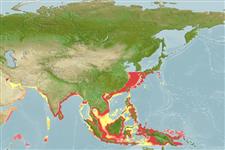Common names from other countries
Classification / Names / Names
Namen | Synonyme | Catalog of Fishes (gen., sp.) | ITIS | CoL | WoRMS
Environment: milieu / climate zone / depth range / distribution range
Ökologie
; tiefenbereich 0 - 175 m (Ref. 109). Tropical; 34°N - 10°S, 48°E - 155°E
Indo-West Pacific: from Persian Gulf to India, east to Papua New Guinea, and north to Japan and China. Introduced in the Mediterranean.
Length at first maturity / Size / Gewicht / Alter
Maturity: Lm 8.6, range 6 - 6.5 cm Max length : 12.9 cm TL Männchen/unbestimmt; (Ref. 409); 14 cm TL (female)
Maximum body length: 9.0 cm (male); 14.0 cm (female); common body length between 6.0 to 8.0 cm (Ref. 409). Maximum total length (male) from Ref. 119750. Common length range: 6.5 to 10.9 cm, male. Common weight range: 3.7 to 13.5 cm, male (Ref. 76922). Maximum depth from Ref. 409.
Mating behavior: Precopulatory courtship ritual is common (through olfactory and tactile cues); usually indirect sperm transfer (Ref. 833).
Holthuis, L.B. 1980. (Ref. 8)
IUCN Rote Liste Status (Ref. 130435: Version 2024-1)
CITES Status (Ref. 108899)
Not Evaluated
Not Evaluated
Nutzung durch Menschen
Fischereien: kommerziell
| FishSource | Sea Around Us
Tools
Internet Quellen
Estimates based on models
Preferred temperature
(Ref.
115969): 13.8 - 29.1, mean 27.8 (based on 2170 cells).
Widerstandsfähigkeit
hoch, Verdopplung der Population dauert weniger als 15 Monate. (K=1.18-2).
Verwundbarkeit
Low vulnerability (10 of 100).
Preiskategorie
Unknown.
